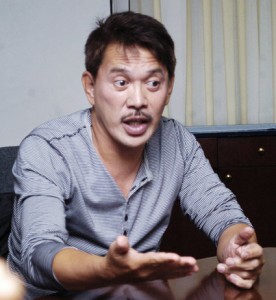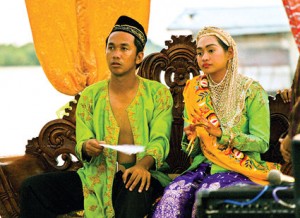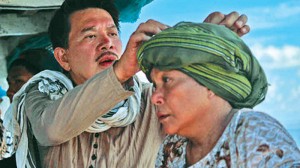Unraveling icons on location
It can be daunting for any filmmaker to direct iconic actresses like Isabelle Huppert of France and Nora Aunor of the Philippines—with or without a Cannes best director award under one’s belt.
But Filipino filmmaker Brillante Mendoza did just that with his latest films, “Captive” (with Huppert) and “Thy Womb” (with Aunor).
Making matters more difficult, Mendoza had to shoot actual childbirths in both movies.
Talk about labor of love.
In “Captive,” he asked a stunned Angel Aquino to deliver a baby in one scene. Needless to say, Aquino was forever transformed by the experience. “It was magical,” she said. (“Captive” was shot in Quezon, Batangas, Tanay and Subic.)
Article continues after this advertisementHe showed the Inquirer rushes of “Thy Womb,” and the most stunning frame had Aunor cradling a newborn.
Article continues after this advertisementTo prepare for the scene, Aunor studied traditional child-birthing techniques. She portrays a komadrona in Mindanao, Mendoza recalled.
How was he able to capture a real-life childbirth scene?
Put simply: He had seven pregnant women on standby in Tawi-Tawi, where “Thy Womb” was filmed.
His radical filming style—combining guerrilla docu techniques with the incisive precision of traditional cinema—never ceases to catch his cast (and captivated audience) by surprise.
“Captive” will have a sneak preview at the Citi-Rustan’s French Film Festival on June 9. The following day, Mendoza will travel to Denmark for the premiere of “Captive” in Copenhagen. With Star Cinema as distributor, “Captive” will have its local theatrical run in September.
“Thy Womb,” to be distributed in the country by Solar, is being readied for a major film fest abroad before debuting in a local film fest at the end of the year.
What was it like working with Isabelle and Nora? What were their similarities and differences?
The similarity is, they both readily gave me their trust. But they both had a hard time adjusting, too. Guy (Nora’s nickname) admitted that she was nervous on the first day. Isabelle naman had a different way of handling and hiding her tension. She was more aggressive.
Why is it a matter of trust?
When they started trusting my style, my way of working, everything went smoothly na. Dere-derecho na. I didn’t give them scripts. In the beginning, Isabelle kept asking what would

BRILLANTE Mendoza expects full trust from his cast so that the shoot will go without a hitch. ARNOLD ALMACEN
happen the next day. She said she needed to study and prepare. I assured Isabelle that she didn’t have to memorize anything.
It’s important for the actors to trust their director for filming to proceed without a hitch.
You always require that much?
Full trust—yes, in all my films. It’s crucial for me to know the work attitude of my actors. Is it about the craft, or earning money? You won’t earn big bucks if you work with me.
Are you saying that trust doesn’t automatically come when saying yes to the project?
I have to win it. That’s why I had to meet with them several times before the shoot. For me, it’s important that they understand their character and the issues that the film intends to tackle.
I don’t want them to know how the story will go; I want them to know their characters. Completely.
I don’t rehearse their lines, either … so that their emotions will be more spontaneous … so that their acting will turn out to be more real.
Bembol (Roco, who plays Aunor’s husband in “Thy Womb”) didn’t know what would happen in one scene. He only found out when it was over. That’s what I want—for them to discover the story as we go along.
Can we call that improvisational?
It can be improvisational, although there are certain lines that have to be delivered to make the story more understandable. But the actors are free to express and react according to their characters. That’s why they have to know their characters inside and out. For some actors, it’s something new.
On the first shooting day of “Thy Womb,” I asked Bembol and Nora to row their small boat and catch fish in the middle of the sea. They got severely sunburned, but they experienced the lives of their characters.
Is it true that Guy got dizzy from heat stroke?
BM: Yeah. She did a lot of things there that were surprising. She actually put her life in danger.
Larry Castillo (line producer): She is like a stuntwoman in this film.
BM: She was in the open sea at 12 noon. Anything could’ve happened … and I wasn’t there.
You were tormenting them by remote control!
Yeah. I was in my air-conditioned hotel room (laughs). That’s why I didn’t get a tan.
Weren’t you wary about Nora’s reputation, deserved or not?
I don’t think about those things. People did warn me, but for as long as I haven’t had any bad experiences with someone … I’ll give him or her the benefit of the doubt.
With Guy, I was just truthful. On the very first day, I told her that we couldn’t afford her usual talent fee and that the shoot would be very difficult and physically draining.
In fact, I required her to work out before the shoot. She went jogging around her home—for three days.
Is it true she also studied how to deliver a baby?
She had some “training” before she left for Tawi-Tawi. We couldn’t use modern midwifery techniques, though. She went to a traditional hilot.
Was that a real childbirth scene in the trailer?
BM: Yes. We had seven pregnant women on standby.
Farrah Ainie Hadji (assistant production manager): I got very stressed every time a woman was said to be giving birth in town.
BM: We all got nervous. One time, I was told a woman was about to deliver in 30 minutes, in another location. We rushed to the woman’s house. But when we got there, it was a false alarm. I was so mad!
LC: Another time, Farrah got so excited about a childbirth, that she rushed out of her house wearing only a tapis. And she’s a Muslim.
FH: I rode a motorcycle in my tapis!
At any point, were you able to say to yourself, I was right about getting Nora Aunor?
While we were shooting, she slowly and completely won me over, too. For me, it’s a good sign that, after all these years, she still gets nervous before a take. It only goes to show that everything she does comes straight from the heart.
Weren’t you scared that Mercedes Cabral and Lovi Poe might attract kidnappers?
BM: We were protected by 20 Marines and 20 policemen in Tawi-Tawi. Plus, the people in Mindanao love FPJ (Fernando Poe Jr., Lovi’s dad). Saka Mercedes was all covered up in this movie.
LC: Cultural ang dating niya.
Is it true Mercedes had a hard time with the courtship dance?
BM: At first glance, the dance looks simple. But it really is difficult. She studied it for a long time. The consultant said she did well.
LC: Mercedes was exhausted after that. She said she was sore all over.
We have some questions from our columnist, Lea Salonga: The subject matter in your movies seems to be the seedier and grittier aspects of our society. Is there a specific reason for this? What do you want changed or improved by tackling these issues?
The mere fact that I am doing stories based on real life means that my films would touch on social issues. These are topics that are seldom tackled in mainstream cinema.
My goal is to depict reality, to be truthful, even if it shows the darker aspects of our society. As a filmmaker, I shouldn’t cover up these problems. As an artist, I should confront these issues. If we don’t recognize these problems, how can we find solutions?
For instance, for “Captive,” I spent a long time doing research on the kidnappings in Mindanao. We interviewed jailed Abu Sayyaf members, along with kidnap victims and the military.
Along the way, I discovered so many things. There were so many pieces of information … that I got confused.
I started doubting myself: What do I really want to say in this film? I began to question my own beliefs in the course of researching the issue.
In the middle of the shoot, I needed to shift gears. As an artist, I am not stubborn. I’m flexible. I can drop my original idea in the face of research data. I give more weight to facts over my opinions.
With “Thy Womb,” what do you hope to change?
I want more Filipinos to discover Tawi-Tawi—a place that’s almost forgotten just because it’s so far away. Our countrymen in Tawi-Tawi need our help. They need the government’s attention.
It’s a pity that we don’t know them. We don’t know their culture, their traditions. You will be surprised that, in this day and age, there are still people like them—especially the Badjaos—who have remained peace-loving in the midst of violence.
What was your first impression of Tawi-Tawi?
The minute you land at the airport, the first thing you see is Bongao peak. It’s enchanting. After days of going around the islands, I realized that everything seemed normal. There was no sense of danger at all.
How did you learn about their problems?

PLAYING newlyweds are Nurjay Sahali and Mercedes Cabral who had to master the tricky courtship dance. MARK JOSEPH GRISWOLD
When I first went to Tawi-Tawi last December upon the suggestion of Briccio Santos (chair of the Film Development Council of the Philippines), I still had no idea what story to tell. It was only when I got there that I stumbled on the story. Kasi I discovered the people. I discovered the place. I was enlightened. I was inspired by everything about Tawi-Tawi.
Another question from Lea: Any desire to direct commercial films? What story would you like to tell?
I have no plans at the moment. Should I ever do a commercial film, I’d like it to be a box-office hit. The intention of a commercial film is to entertain. I should succeed in that aspect, if ever.
It has never crossed your mind?
I’ve thought about it. But as of now, I still enjoy doing indie films. There’s nothing the matter with commercial movies. We each have our own objectives as filmmakers. My goal is not to entertain. Then again, if people get entertained with “Kinatay,” why not? That’s not my main intention, though. I want to provoke, to disturb. I want the audience to experience what is happening onscreen.
But Star Cinema picked up “Captive” for distribution? Solar is distributing “Thy Womb”?
I was surprised that Star Cinema liked it. They told me: It’s not a potential blockbuster, but that doesn’t mean it’s a bad film. It has its own audience. They called it an educational film.
Does that mean you will guest on “The Buzz”?
Hahaha! I don’t think so.
Did Nora and Isabelle impose certain conditions before agreeing to work with you?
None at all.
You were the one who set conditions?
Not really. I gave them copies of my old films so that they would be familiar with my work style.
What were your old films that Nora watched?
She saw “Lola,” “Kaleldo” and “Foster Child.” Guy was impressed by Cherry Pie (Picache) in “Kaleldo.” She loved the two grandmothers, Anita Linda and Rustica Carpio, in “Lola.”
